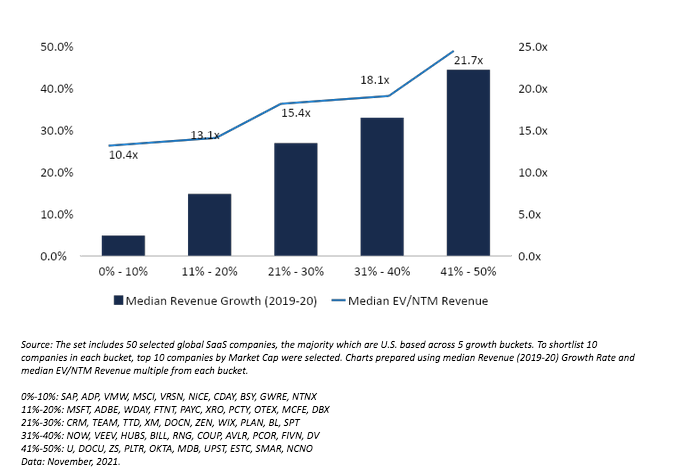Having advised technology companies on M&A and capital raises, for the last 15+ years, I often get asked about drivers for achieving premium valuation — when a company trades better than their industry group peers.
Subscribe to the Crunchbase Daily
Below are some factors that help technology companies achieve premium valuation. While every company is unique and has its own attributes and dynamics that ultimately drive valuation, the points below can help companies focus on factors affecting valuation as they focus on their next round of funding or exit.
Cater to a large market
As CEO, you will be asked what your market size is. Buyers and investors focus on companies that are addressing large markets (typically greater than $1B) allowing opportunities to grow. Conversely, being a leader in a small market (<$100M), then the largest revenue one could attain would be $100M at 100 percent market share, which is not enough to move the needle for a large strategic buyer or an institutional investor.

Market sectors can go in and out of favor due to sector tailwinds, regulations, and trends. If the sector in which you operate is seeing increasing interest, you will see more capital flowing and increased investor and buyer interest. Your relative position in the large market matters. If you are one of the top players in a large market you will court multiple interested parties in contrast to if you are in the lower tier of your market.
Team capabilities
Teams who can execute and have the experience and knowledge of the market they are going after get premium valuations. Investors and buyers, when evaluating teams, try to assess the team’s track record, skill sets and how complementary they are along with their ability to build and scale products.
Investors often look to fund repeat founders as they believe that their prior experience makes them well suited to start a new venture.
Buyers also look and assess the team capability and culture fit in being part of a larger organization and team’s ability to scale quickly with their established distribution capabilities.
Attractive and diverse customer base
Larger customers can spend 100x more than a smaller customer making them desired. On the other hand, the sales cycle for larger customers is generally much longer compared to smaller customers.
The type of customers you target drives a lot of scrutiny into how much you are spending relative to the value of the customer and your ability to retain the customer. Companies who have ratios of Lifetime Value (LTV) / Customer Acquisition Cost (CAC) greater than 3 are preferred as it signals to an investor or buyer that there is high ROI on increasing spending on customer acquisition.
A diverse and large customer base is preferred over reliance on a few customers who could be driving the majority of the revenues creating “customer concentration risk.”
Strong and growing financials
Growth is by far the most important driver of valuation in technology companies.
Depending on your stage, if you are tripling revenue for the first three years followed by doubling, you will get a premium valuation. Investors are often willing to overlook profitability during the growth phase if you can maintain high gross margins (>70% with 80-90% being preferred).
High gross margin allows companies additional capital to invest in research and development, sales and marketing and higher future cash flow and points to a differentiated technology offering.
Illustrative Impact of Growth Rates on Valuation Multiples of Public SaaS Companies
Companies with higher growth rates have higher multiples

Buyers and investors are generally fine with a small amount of services (configuration, implementation, training etc.) in the revenue mix (~10% to 15%) if done profitably as it can create stickiness with end customer due to work involved in establishing the product at customer site and creating barriers to switching product.
For SaaS companies, scale matters; above $10M ARR you will start to attract a lot of private equity (PE) interest. These days, PE and growth VC firms are often offering substantially higher valuations than strategic buyers creating competitive bidding.
Investors have started to look at the “Rule of 40”, which says annual revenue growth rate plus profit margin should equal 40 percent. For emerging growth below $10M ARR, given the market pays a higher premium for growth over profitability, Susquehanna Growth Equity has come up with a growth weighted Rule of 40 which is Growth Weighted Rule of 40 = (1.33 * Revenue Growth Rate) + 0.67 * (EBITDA margin).
The Rule of 40 is a useful tool for assessing the tradeoffs that need to be made between growth and profits at any point in a company’s lifecycle.
Synergies and pre-existing relationships with buyers
Strategic buyers who see the seller’s business as filling an important gap and enhancing their product set, customer base, team competencies, competitive positioning or scale are likely to pay a premium valuation. It’s important for the seller’s executives to work with the buyer’s team to draw out such synergies.
Good synergies and lower integration costs lead to stronger sponsorship by buyers’ business leaders, which provides support for premium valuation. Having successful pre-existing commercial relationships and partnerships with buyers also helps achieve better outcomes as the buyer is familiar with the company, its technology and culture which can drive them to make an attractive offer.
Competitive process and scarcity
While valuation analysis yields a certain baseline value, competition for your company from investors or buyers (ideally both) helps to achieve premium valuation. I have often been in situations where there is a wide range of valuations when a process is run as buyers and investors have different abilities to pay and assess synergies differently.
Savvy companies create multiple options by generating multiple term sheets from investors and buyers thereby making it competitive, and investors and buyers are willing to pay up to avoid the FOMO of not getting in on the transaction.
An experienced investment banking advisor can help companies in the process of evaluating and creating multiple options.
Gaurav Bhasin is managing director with Allied Advisers, a global technology-focused boutique advisory firm focused on investment banking for entrepreneurs and investors. The Silicon Valley-based firm, with a presence in Los Angeles, Israel and India, serves entrepreneurs and investors of technology growth companies on strategic advisory including M&A and capital raises.
Illustration: Li-Anne Dias.

Stay up to date with recent funding rounds, acquisitions, and more with the Crunchbase Daily.






![Illustration of stopwatch - AI [Dom Guzman]](https://news.crunchbase.com/wp-content/uploads/Halftime-AI-1-300x168.jpg)


67.1K Followers